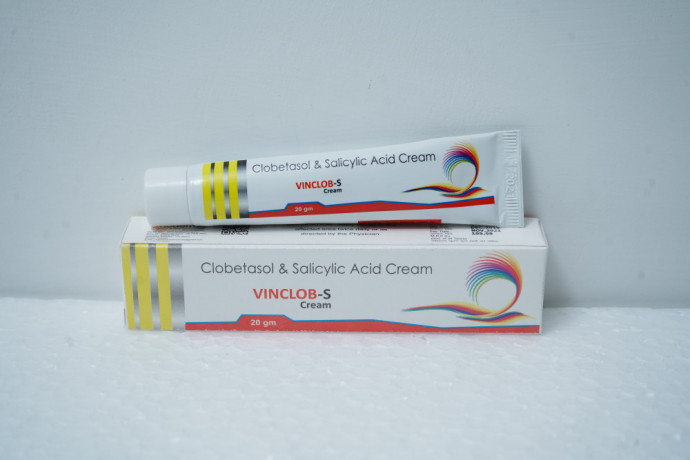A common combination drug used in dermatology to treat a variety of skin disorders is clobetasol propionate and salicylic acid ointment. To help you better grasp this powerful treatment option, this article offers an in-depth look at its uses, benefits, application methods, and answers to frequently asked questions.
Gratitude Propionate Clobetasol with Salicylic Acid
Acetazolamide Propionate
Strong corticosteroid clobetasol propionate is used to lessen redness, swelling, and itching brought on by a range of skin conditions. The most common disorders for which it is prescribed are dermatitis, psoriasis, and eczema. Clobetasol functions by reducing the immunological reaction that results in skin irritation.
Acid Salicylic
Salicylic acid is a keratolytic chemical that encourages the skin’s dead skin cells to shed, aiding in skin exfoliation. Acne, psoriasis, warts, and other skin disorders where an accumulation of dead skin cells is an issue are frequently treated with it. Salicylic acid helps to eliminate the outer layer of dead skin by softening and releasing the keratin in the skin.
Combination Treatment
Salicylic acid and clobetasol propionate have a synergistic effect when combined. While salicylic acid aids in skin exfoliation and permits the corticosteroid to enter the skin more deeply and efficiently, clobetasol propionate lowers immunological reactions and inflammation. When treating hyperkeratotic skin diseases like psoriasis, this combination is especially helpful.
Applications and Advantages
Psoriasis
Psoriasis is a long-term autoimmune disease that causes thick, red, scaly patches by accelerating skin cell development. Salicylic acid and clobetasol propionate work well together to reduce plaque thickness, reduce inflammation, and reduce itching in psoriasis patients.
Dermatitis and Eczema
Inflammatory skin diseases including dermatitis and eczema are characterised by red, itchy, and occasionally leaking lesions. Salicylic acid’s exfoliating qualities and clobetasol propionate’s anti-inflammatory qualities aid in relieving skin irritation and discomfort.
Skin Conditions with Hyperkeratotic Skin
Hyperkeratosis is characterised by an excess of keratin causing the skin’s outer layer to thicken. This combination ointment reduces inflammation and softens and removes thickened skin to assist manage such diseases.
Conditions at the Scalp
Additionally helpful for treating psoriasis and seborrhoeic dermatitis of the scalp is the ointment. Salicylic acid aids in the removal of dandruff and scales, making it possible for clobetasol to successfully lessen irritation and itching.
Use and Amount
How to Utilise
Clean the Area: Use a mild soap and water to clean the affected area, then pat dry, before applying the ointment.
Apply a Thin Layer: Cover the affected region with a thin layer of the ointment using clean hands. Refrain from using too much.
Gently Rub In: Until the ointment is uniformly dispersed, gently rub it into the skin.
Hand Washing: To prevent inadvertently getting medication in other locations, particularly the mouth and eyes, wash your hands well after applying the medication.
Observe the Recommended Frequency: Apply the ointment once or twice a day, as directed by your healthcare professional.
Length of Use
The ailment being treated and the patient’s reaction to the drug determine how long the treatment will take. Because of the strength of clobetasol propionate and the possibility of adverse effects with extended usage, the course of treatment for adults should normally not last longer than two weeks.
Particular Points to Remember
Children: Due to the increased risk of side effects, the use of this ointment in children should be strictly supervised by a healthcare professional.
Occlusive Dressings: To improve the medication’s absorption, it may occasionally be advised to cover the treated region with a waterproof dressing. But you should only do this with a healthcare provider’s supervision.
Possible Adverse Reactions
Salicylic acid ointment with clobetasol propionate can have adverse effects, just like any other medication, albeit not everyone will.
Typical Side Effects
Burning or Stinging: At the application site, there may be an initial mild burning or stinging, but this normally goes away.
Dryness or Peeling: Especially after repeated use, the skin may get dry or peel.
Dangerous Side Effects
Extended usage may result in skin atrophy, stretch marks, and easily bruised areas.
HPA Axis Suppression: Excessive use of clobetasol propionate might cause hormonal imbalances by suppressing the hypothalamic-pituitary-adrenal (HPA) axis.
Allergic Reactions: In rare cases, people may develop an allergic reaction, which is typified by excruciating itching, edoema, and breathing difficulties. Immediately seek medical attention in case this happens.
Reducing Adverse Effects
Use as directed: Adhere to your doctor’s prescription exactly every time you take medication.
Avoid Extended Use: To reduce the possibility of adverse effects, avoid using the ointment for longer than is advised.
Track Skin Changes: Keep an eye out for any symptoms of side effects in the treated region and let your healthcare professional know if you see anything that seems off.
FAQs
Which Conditions Is This Ointment Effective for?
The main ailments this ointment is used to treat are dermatitis, psoriasis, eczema, and other hyperkeratotic skin diseases. Certain scalp disorders including scalp psoriasis and seborrhoeic dermatitis respond well to it as well.
How Much Time Does It Take to Notice Changes?
The length of time it takes to see effects varies based on the condition being treated and the patient’s response. It could take a few weeks for some people to experience improvement, while it might just take a few days for others.
Can My Face Be Used with This Ointment?
Face skin is more delicate and more likely to experience adverse effects, thus using clobetasol propionate and salicylic acid ointment there should only be done under a doctor’s supervision.
Is Children Safe Here?
Children can be taken this medication, but because they are more likely to experience side effects, they should use it carefully and under a doctor’s constant supervision.
Is It Safe to Use This Ointment While Breastfeeding or During Pregnancy?
It is not quite clear if this ointment is safe to use while pregnant or nursing. If you are pregnant or nursing, speak with your doctor before using this drug.
How Do I Proceed If I Miss a Dose?
Apply the missed dose as soon as you remember if you miss it. If the next dose is almost due, skip the missed one and get back to your regular routine. Never apply more ointment to compensate for a missing dosage.
Exist Any Interactions Between Drugs?
Even though topical medications usually have fewer interactions, you should still tell your doctor about all of your prescriptions—including over-the-counter medications and supplements—that you use.
How Should the Ointment Be Stored?
The ointment should be kept out of the heat and moisture at room temperature. Make sure that pets and children cannot get it.
Can I Apply the Ointment to Skin That Is Broken or Infected?
Application of the ointment on broken, infected, or severely injured skin should wait until your physician instructs you to do so. By doing this, there may be a higher chance of absorption and adverse effects.
How Do I Proceed If I Have Serious Adverse Reactions?
In case you encounter serious adverse effects like extreme burning, swelling, or indications of an allergic response, stop using the product right once and get medical help right away.
In summary
Salicylic acid ointment combined with clobetasol propionate is a potent treatment for a variety of inflammatory and hyperkeratotic skin diseases. It’s a useful therapy choice because of how well it works to promote skin exfoliation and reduce inflammation. But because clobetasol propionate is so powerful, using it without a doctor’s supervision is crucial to reducing side effects and achieving the best possible therapeutic results. To receive specific information regarding using this ointment, speak with your healthcare professional if you have any concerns.


